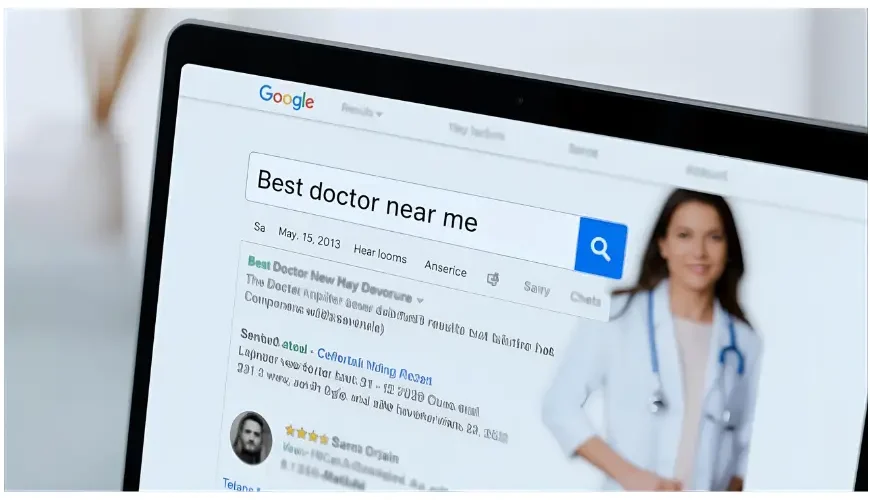
In today’s digital age, your patients are searching online before they ever step into your clinic.
You’re probably losing out on dozens of potential patient inquiries each week if your website isn’t on Google’s first page.

That’s where SEO for doctors comes in — a proven strategy to help medical professionals rank higher on Google, attract local patients, and grow their practice.
🔍 What Is SEO for Doctors?
Enhancing your clinic’s online presence so that your website shows up when patients search for terms like these is known as SEO (Search Engine Optimization).
- “best dentist in my area”
- “Kathmandu dermatologist”
- “ENT physician for allergies”
For healthcare providers, this involves customizing your website, Google Business Profile, reviews, and content to what consumers are searching for.

💡 Why SEO Matters for Doctors in 2025
More than 77% of patients look for information online before making an appointment, according to Google Health Data.
Because of this, SEO is now required if you want to stay ahead of the competition.
A strong SEO strategy helps you:
✅ Get found when patients search online
✅ Build credibility and trust
✅ Generate consistent patient leads
✅ Reduce dependency on paid ads
Common SEO Mistakes Doctors Make
If their SEO for doctors strategy isn’t well thought out, even the most seasoned medical professionals may find it difficult to draw in patients online. Due to some preventable SEO errors, many clinics and hospitals invest in digital marketing but still don’t consistently get returns. The most prevalent ones to be aware of are as follows:
1.Doctors Ignoring Local SEO
Ignoring local optimization is one of the biggest mistakes doctors make when it comes to SEO. Since most consumers look for local specialists, your clinic may not appear in local search results if you don’t optimize your Google Business Profile, don’t include location-based keywords (such as “dentist in Kathmandu” or “best skin clinic near me“), and have inconsistent contact information.
2.Using Weak or Duplicate Website Content
Google rewards original and informative content. Many doctors copy service descriptions or reuse text from other sites, which negatively impacts SEO for doctors.
3.Not Optimizing for Mobile Users
A significant portion of patients use their mobile phones to look up clinics. If your website isn’t mobile-friendly, loads slowly, or seems crowded on small screens, users will rapidly leave. Your website must provide a seamless experience on all devices because mobile optimization is now a ranking element in SEO for doctors.
4.Ignoring Reviews and Online Reputation
Reviews are a key aspect of SEO for doctors because they affect trust and ranking. Hospitals, clinics, and doctors frequently lose visibility if they don’t encourage patients to write positive Google reviews or don’t reply to comments. Creating a reliable review system increases patient trust and your online credibility.
5.No optimization plan or keyword strategy
It is a serious error to publish blogs or pages without conducting adequate keyword research. Targeting patient-intent keywords such as “best dermatologist in Kathmandu” or “orthopedic clinic near me” is the most effective strategy for SEO for doctors. You can get high-quality leads from organic search by choosing and utilizing the appropriate keywords.
🌐 Step-by-Step SEO Strategy for Doctors
Let’s break down the exact SEO roadmap IT Relevant uses to help clinics and hospitals achieve top Google rankings.
1.Optimize Your Website for Search Intent
Your website is the first place Google checks for relevance.
Make sure it’s:
- Fast & mobile-friendly
- Secure (HTTPS)
- Well-structured with medical-specific pages
✅ Create dedicated pages for each service:
Example: /dental-implants, /skin-treatment, /cardiology-services
✅ Include local modifiers like:
“Dermatologist in Kathmandu” or “Dental Clinic in Pokhara”
This helps Google associate your clinic with specific local patient searches.
2.Local SEO — Be Visible in “Near Me” Searches
Local SEO is the backbone of SEO for doctors.
It guarantees that you show up in both the local 3-pack and Google Maps.
Checklist for Successful Local SEO:
- ✅ Verify and claim your Google Business Profile (GBP)
- ✅ Add all clinic information (address, phone number, hours, services)
- ✅ Post offers or updates on your GBP every week
- ✅ Gather and address patient feedback
- ✅ Include pictures of your staff and clinic
💬 Pro Tip: Clinics are 3x more likely to show up in the top map results if they have 50+ favorable Google reviews.
3.Target Local & Medical Keywords
Your SEO foundation is defined by keyword research.
Concentrate on local + service keywords for physicians, like:
- “Kathmandu dental clinic”
- “best gynecologist in my area”
- “skin specialist for acne”
- “ENT physician Lalitpur”
Use tools like Ahrefs, Ubersuggest, and Google Keyword Planner to identify high-volume, low-competition terms.
Then naturally include these keywords in:
- Meta descriptions and page titles
- Headings (H2, H3)
- Image ALT text
- Blog content
4.Publish Helpful Medical Content
Google’s AI Overview and ranking systems prioritize expert, people-first content.
Create blog articles that educate patients and showcase your expertise, such as:
- “How to Prevent Tooth Decay Naturally”
- “Best Skin Treatments for Acne Scars”
- “When to Visit a Cardiologist: 7 Warning Signs”
Each article should:
✅ Be written or reviewed by a qualified doctor
✅ Include patient-friendly explanations
✅ End with a soft call-to-action: “Book your appointment today”
💡 Bonus Tip: Add a short author bio like:
“Dr. S. Sharma, MD Dermatology, has over 10 years of experience treating skin disorders and runs DermaCare Clinic in Kathmandu.”
This builds trust and authority.
5.Build High-Quality Backlinks
Backlinks are considered votes of confidence by Google.
For physicians, look for backlinks from:
- Local health directories
- Medical associations
- Guest blogs on healthcare sites
- Local news mentions
Avoid spammy or paid links — focus on relevance and credibility.
Example:
“Dr. Adhikari was featured in Nepal Health Magazine” → that link boosts both reputation and ranking.
6.Improve On-Page SEO Elements

Each page should follow these on-page SEO best practices:
- Title tag: SEO for Doctors | [Clinic Name]
- Meta description: 155–160 characters
- URL: short and keyword-focused
- H1: includes primary keyword
- Internal links between services and blog posts
Additionally, apply schema markup (medical organization, reviews, FAQ) to help Google AI understand your content better.
7.Build Trust with Reviews & Testimonials
Both your click-through rate (CTR) and SEO ranking are enhanced by positive patient feedback.
After appointments, encourage satisfied patients to post reviews on Google.
Show professionalism by responding politely to all reviews, even those that are negative.
On your homepage and service pages, include selected testimonials such as:
8.Track, Analyze, and Improve
Use analytics tools to measure performance:
- Google Analytics → track website traffic & user behavior
- Google Search Console → monitor keyword rankings
- Google Business Insights → measure calls, visits, and reviews
SEO is not one-time work. Continuous optimization ensures long-term results.
🧠 Key Takeaways
| SEO Element | Why It Matters | Action Tip |
|---|---|---|
| Local SEO | Helps rank in “near me” searches | Optimize Google Business Profile |
| Medical Content | Builds trust & authority | Publish blogs reviewed by doctors |
| Backlinks | Increases credibility | Get links from health directories |
| Reviews | Boosts trust & CTR | Request patient feedback |
| On-Page SEO | Improves relevance | Optimize title tags, meta, schema |
🚀 Ready to Rank #1 on Google?
If you’re a doctor, clinic, or hospital looking to attract more patients and dominate local search, SEO is the key.
At IT Relevant, we specialize in healthcare SEO — from website optimization to Google ranking strategies — built specifically for medical professionals.

📞 Book a Free SEO Audit Today
👉 www.itrelevant.com
Let’s make your clinic the first choice patients see online.








